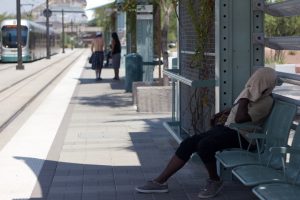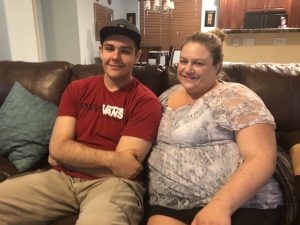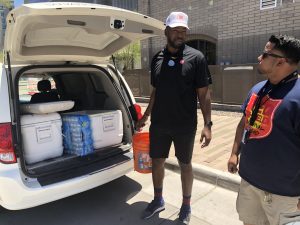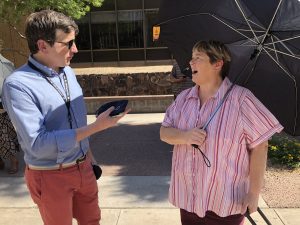- Slug: BC-CNS-Heat Deaths. 2,335 words.
- Photos and captions below.
- Soundcloud here.
By WILL STONE
KJZZ
PHOENIX – Heat is killing more people in the United States every year. And as temperatures rise with climate change, that’s only forecast to get worse.
In Phoenix, the problem is especially pressing, and the city’s trying to do something about it.
‘It becomes too late very quickly’
There’s a moment as heatstroke sets in when the body — no longer able to cool itself — stops sweating.
Joey Azuela remembers it well.
“My body felt hot like in a different way. It was like a ‘I’m cooking hot.'”
Joey Azuela, 14 at the time, had hiked that trail in one of Phoenix’s rugged mountain preserves before. But he and his father had gotten a late start that day, a cardinal sin for any summer outing.
He was already weak and nauseous when they reached the top. But the desert offered no shade and their water was gone. He and his father turned back.
“I remember thinking ‘Man, I just got to get to the car,’” Azuela says. “Then just nothing – black.”
He collapsed in the parking lot.
By time the ambulance arrived, the asphalt had already caused second-degree burns to his arms and legs.
His mother, Alicia Andazola, arrived at the emergency room to find her son covered in ice and his body temperature nearing 108 degrees.
“His organs started failing. His body was shutting down,” Andazola recalled.
Doctors had to remove his blood with a machine to cool it. He wasn’t showing signs of brain activity.
“We weren’t sure for the first couple days like if he was going to make it and if he did how much was going to be left,” Andazola said.
Eventually, the teenager did wake up, and his brain was intact. Three years later, he has made a full recovery.
But it’s a cautionary tale of heatstroke that his mother knows few here get to tell.
“It becomes too late very quickly,” she said.
‘Heat is like a silent storm’
Heat-related deaths are rising in Phoenix — one of America’s fastest warming cities.
In 2017, the Phoenix area hit a new record: more than 155 heat fatalities, and the final tally could be higher.
Phoenix leaders are taking notice. Earlier this year, then-Mayor Greg Stanton deemed it “a public health crisis.”
“Thousands more are getting sick. And worse, it’s our most vulnerable people and low-income neighborhoods are most at risk,” Stanton said. “In fact, nine of the 10 hottest years ever recorded in our city occurred in the last 15 years.”
The alarming trend has set the city of 1.6 million people on a major overhaul of how it deals with extreme heat.
Just as cities have comprehensive plans for the hurricane season, so, too, will Phoenix for heat — better alert systems, carefully
coordinated response plans and a safety net for those susceptible to extreme heat.
“Heat is like a silent storm,” said Mark Hartman, head sustainability officer for the city.
Conveying the danger poses a unique challenge in a place where heat is such a part of life. It’s both a chronic and extreme threat. The city has the distinction of more than 100 days above 100 degrees.
Although dealing with high heat isn’t new for the city, Hartman says there hasn’t been a holistic approach to the issue.
“Our goal is to actually say to be heat ready here are all the things you need to do,” he said.
The final plan will outline strategies for keeping people safe and lowering the temperature in places most prone to heat.
“In the long term, we want to cool our city by X number of degrees over what it would have been,” Hartman said.
That target is still up in the air. However, millions of dollars could be riding on what the city puts together.
Phoenix is competing with dozens of cities across the country in the Bloomberg Philanthropies’ 2018 Mayors Challenge. Cities are piloting plans to solve a specific urban issue, from rising sea levels to street repairs.
The top city gets $5 million to put its plan into action; four cities will win $1 million each.
Hartman says Phoenix is hardly the only metropolis wrestling with rising temperatures, even unlikely places like his hometown of Vancouver, British Columbia.
“We’d like be a subject-matter expert on heat among all cities,” Hartman said.
The growing death toll of Phoenix’s heat
Headlines of people succumbing to heat — on trails and streets, in cars and homes — are a tragic staple of the Phoenix summer.
By 2100, the summertime is expected to resemble the 114-degree averages found in Kuwait, according to modeling by Climate Central, a nonprofit science and news organization.
So far in 2018, the city has six more days above 110 degree than it did in 1970, although the record high of 122 degrees has held since June 1990.
Heat deaths peak during July but begin as early as May and can last through September. That makes communicating the risks especially challenging, said Dr. Rebecca Sunenshine of the Maricopa County Department of Public Health.
“People say, ‘I’ve lived here, I’m used to it,’” said Sunenshine. “But we see people who’ve lived here for 20 years and who hike all the time die of heat-related illness.”
More than 480 people died outdoors in the county from 2006 to 2015. Trails and desert areas were the second most common place with more than 110 deaths.
Several years ago, the problem led Phoenix to consider closing hiking trails when temperatures reached a certain threshold. But the idea died after substantial pushback from the public.
Although it’s easy to fixate on the hottest days, Sunenshine says, most heat-associated deaths happen on days when no heat warning has been issued.
“People die in all different temperatures, and it’s not dependent on how high it is or how high the low temperature is,” she said.
When Joey Azuela nearly died from heatstroke, the high was 103 — an average August day with no extreme-heat warning.
Like any natural disaster, the persistent risk of extreme heat disproportionately affects the most vulnerable groups — the elderly, homeless and low-income.
Native Americans die at more than twice the rate of whites in Maricopa County.
About 40 percent of heat deaths last year occurred indoors. Most victims were women, living alone and older than 75.
“Oftentimes, they won’t have their air-conditioning on or it will be malfunctioning,” Sunenshine said. “Because they are older, their bodies aren’t able to detect differences in temperature.”
As part of its heat planning, Phoenix is looking at installing heat-alert systems in the homes of elderly residents. Ideally, those could notify first-responders and volunteers when the temperature inside a home reaches a level of concern.
Outdoors, heat predominantly kills men, and the homeless are at the greatest risk. Sunenshine said about a third of heat-related deaths last year were of homeless individuals.
‘Do the imitation swamp cooler’
On an early June afternoon, Jowan Thornton is scanning a downtown park from behind his shades. In his hand is an orange bucket filled with water bottles. Temperatures are forecast to break 110 later that day.
“Hey, buddy. Can I get you some water?” Thornton asks one man who has sheltered under a tree with his belongings.
Thornton, who works for the Salvation Army, is on the front lines of the effort to keep the city’s homeless population safe during extreme heat.
“It’s disheartening … when you see so much need out there, especially when it’s so hot,” he said.
In recent years, Phoenix and dozens of local groups have teamed up to expand the region’s heat-relief network. Cooling stations are strategically placed across metro Phoenix, on street corners and inside buildings.
Thornton and others crisscross the city to dole out supplies in places where the homeless gather to stay cool.
Nighttime lows in Phoenix have gone up an average 9 degrees in the recent decades. It’s one of the most striking examples of how the urban heat-island effect has altered the desert environment.
Thornton comes across a man fixing his bike; he says he spends nights at the bottom of a dry canal.
“It does heat up a lot,” the man said. “You do the imitation swamp cooler — get clothes wet and hope you catch a good breeze.”
Janette Archer is a psychiatric nurse in Phoenix who works with the city’s homeless population.
“The ground stays really hot all night. It’s just dangerous,” she said.
Archer says she knows of several patients who’ve died from heat while living on the street – including one who died waiting for housing.
“They were going to move into housing on Monday and this was a Friday,” she said.
How hot is too hot?
David Hondula of Arizona State University says Phoenix’s future undoubtedly is hot. But just how hot?
Much of that, he said, is still within our control.
“This really is the extreme case,” said Hondula, assistant professor at ASU’s School of Geographical Sciences and Urban Planning. “If they (urban planners) are successful here, then they can be successful anywhere.”
Hondula says roughly a third of people who live in the Phoenix area experience some kind of adverse health effect in the summer months. Surveys suggest more than 1 million people are too hot inside their homes.
“We have more of these days that are at, near or slightly above some of the key thresholds for public health,” he said.
Hondula attributes about half of this to climate change and the other half to the built environment — the miles of pavement, low buildings and air-conditioners.
Reversing the urban heat-island effect will require a major shift in how the city grows in the coming years.
“We have a lot of asphalt surfaces that are mostly unused most of the year,” Hondula says. “We have cars and ACs operating everywhere. All those machines are dumping heat into the environment.”
Not everything will be a trade-off, though.
Existing infrastructure can be converted. Roads can be repaved with permeable materials and roofs can painted white or with other reflective surfaces. Hondula says the jury is still out on whether painting roads white is the best method, though.
If done properly, Hondula says these change could even offset some of the consequences of climate change.
But surface temperature isn’t the best metric of success, he says. The best gauge is how comfortable people feel as they move around the city every day.
Searching for shade
Any newcomer to the Phoenix summer quickly learns the best parking spot isn’t the one close to the entrance. It’s the one under the tree.
Creating more shade is a key element of Phoenix’s plan to not only lower the number of heat-related deaths but to simply keep people cooler in their daily lives.
The city aims to have 25 percent shade cover by 2030, but it’s still far from that goal. So on a recent afternoon, city employee Michael Hammett is working a line of people at a bus stop, peddling another option.
“Have you ever used an umbrella for heat?” he asked Deb Neild. A bit puzzled, she notes she uses umbrellas mainly for rain but agrees to give it a try.
Hammett pops open a black UV-protected umbrella and hands it to her. Neild is surprised when the effect is almost immediate.
“Definitely cooler already,” she said. “I can feel it.”
When Hammett presses, she says she probably would use it for relief from the heat, and he lets her keep it. Others are less interested. It’s too cumbersome, they say, or they just don’t see the benefit.
The umbrella trials are one of many efforts to gauge how people might change their behavior to better protect themselves from heat.
Heat inequity
In Phoenix, low-income neighborhoods suffer disproportionately from extreme heat.
Researchers at ASU have observed in some cases more than a 10-degree difference between neighborhoods less than 2 miles apart. Areas with more trees and vegetation are cooler.
And the city’s Hispanic population is especially vulnerable — a problem that only has become more pronounced over time, according to studies.
On a recent day, Maggie Messerschmidt of the Nature Conservancy is going door-to-door in one such area in Mesa. There are few trees, and lots of gravel and dirt yards.
“We want to learn how to better cope with the heat together,” she told one woman who lives nearby.
That begins with collecting heat stories from locals, Messerschmidt says.
“Based on that, we are going to come up with a list of priorities for the neighborhood,” she said.
Many here are renters, so they haven’t invested in shade. One man tells Messerschmidt that he plans to buy houses to rent out, and he isn’t sure planting trees and shrubs would be worth it.
“If it costs me an extra $300 more to maintain the homes because of the landscaping we put in, I’m not making a dime,” he said.
Before she moves on, Messerschmidt floats the idea of a financial incentive to encourage property owners to add cooling landscaping.
Aimee Williamson of the local nonprofit Trees Matter says the whole mindset around trees needs to change, especially in a place where palms often pass for shade trees.
“They’re not just something that should be lumped into parks,” Williamson said. “They should be looked at as infrastructure and prioritized financially in that way. It’s kind of a form of preventive health.”
Messerschmidt meets a woman on another street who wants a change at bus stops.
“The seats are metal,” she said. “How the heck are we not supposed to burn ourselves on the metal?”
Others ask about a fountain, a place for kids to cool down as they walk home from school.
Later this year, all these suggestions and others will be vetted for a final action plan, which might include a specific, measurable target by which to lower the local temperature. Phoenix hopes it can lead the way, as cities across the country face summers that are longer and hotter.
This story is part of Elemental: Covering Sustainability, a new multimedia collaboration involving Cronkite News/Arizona PBS, KJZZ, KPCC, Rocky Mountain PBS and PBS SoCal, and part of ongoing Colorado River coverage in partnership with KUNC in Colorado.
For more stories from Cronkite News, visit cronkitenews.azpbs.org.
^_=




